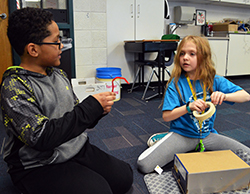Third graders at Explorer Elementary School are putting a twist on hungry, hungry hippos, with their own version of the ravenous mammal.
Instead of marbles, their hippo eats toys.
“Lots of kids have way too many stuffed animals,” explained Blake Strong about the prototype toy storage container he designed with fellow students Phiona VanderBeek and Bennett Stalker.

The toy container design — in the shape of a hippo — has a mouth for dropping in stuffed animals and a door in the back for retrieving them. It is made of cardboard, colored tape, paper, plastic and has googly eyes.
Students in the P.E.A.K.S. gifted and talented program at Discovery and Explorer elementary schools are creating toy storage containers by using the design thinking process. (P.E.A.K.S., or Parents , Educators And Kids = Success, is a full-time, self-contained program students apply for entry into.)
The task was to create a container for a student to use in a small bedroom, where Legos, dolls and Matchbox cars are often strewn about the floor.
Josie Day and her group invented “The Basket Shandeleer,” a toy box that hangs from the ceiling and drops to the floor using a pulley system. She said the contraption would free up space in her bedroom and provide her pet with a better view.
“I have a lot of things. It would definitely be helpful with the stuff on my desk,” she said, explaining that her fish lives in a bowl on her desk. “I don’t think my fish is very happy.”
Third grader Quelasia Harrell and her team designed the “OG Pocket Strap,” a strap with a pouch to hang off the wall and hold toys. “Most people don’t have things to store their toys and books in, so we thought it would be a good idea to make one,” she said.

Challenge: Put Away Your Toys
Explorer teacher Debi Hayes’ and Discovery teacher Amanda Tollas’ classes worked with Steelcase engineers on using the design thinking process to create a product that best fits the needs of the end user — a child with a small bedroom.
They considered cost effectiveness, safety and usefulness, and interviewed a parent and three children about what kind of toy container would work best in their homes. They met with Eric Kelliher, Kent ISD Career Readiness consultant, for feedback. Students revised and edited throughout the project.
Students recently presented to judges, who chose winning designs for each school. All teams will showcase their designs in March at the Kentwood Administration Building. The winning designs will stay in classrooms and be used for storage, Hayes said.
In Hayes’ class, students have taken on five design challenges this school year. They designed a plan for special classroom seating including comfy furniture and a plan to promote recycling.
“They are becoming really proficient at being flexible thinkers and coming up with some really original ideas,” Hayes said. “It’s that whole idea of 21st century learning and engineering. We are equipping our kids to be successful in lots of fields. It makes them really good, thorough thinkers.”













